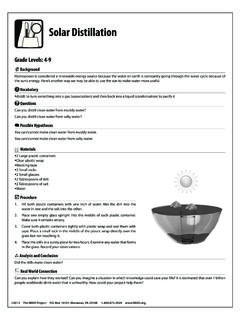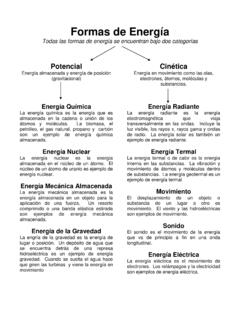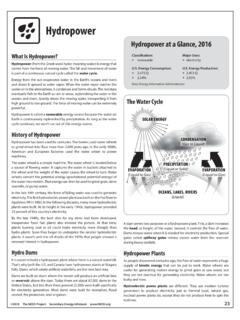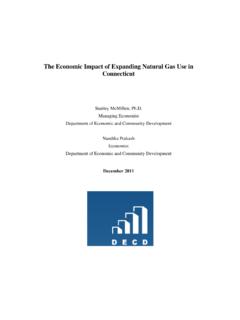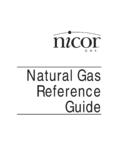Transcription of Natural Gas - NEED
1 2018 The NEED Project Secondary Energy Infobook 27 What Is Natural Gas? Natural gas is generally considered a nonrenewable fossil fuel. (There are some renewable sources of methane, the main ingredient in Natural gas, also discussed in this fact sheet.) Natural gas is considered a fossil fuel because Natural gas was formed from the remains of tiny sea animals and plants that died 300 to 400 million years ago. When these tiny sea animals and plants died, they sank to the bottom of the oceans where they were buried by layers of sediment that turned into rock. Over the years, the layers of sedimentary rock became thousands of feet thick, subjecting the energy-rich plant and animal remains to enormous pressure.
2 Most scientists believe that the pressure, combined with the heat of the Earth, changed this organic mixture into petroleum and Natural gas. Eventually, concentrations of Natural gas became trapped in the rock layers like a sponge traps Natural gas is a mixture of different gases. The main ingredient is methane, a Natural compound that is formed whenever plant and animal matter decays. By itself, methane is odorless, colorless, and tasteless. As a safety measure, Natural gas companies add a chemical odorant called mercaptan (it smells like rotten eggs) so escaping gas can be detected. Natural gas should not be confused with gasoline, which is made from of Natural GasThe ancient peoples of Greece, Persia, and India discovered Natural gas many centuries ago.
3 The people were mystified by the burning springs created when Natural gas seeping from cracks in the ground was ignited by lightning. They sometimes built temples around these eternal flames so they could worship the mysterious 2,500 years ago, the Chinese recognized that Natural gas could be put to work. The Chinese piped the gas from shallow wells and burned it under large pans to evaporate seawater for the gas was first used in America in 1816 to illuminate the streets of Baltimore with gas lamps. Lamplighters walked the streets at dusk to light the lamps. Soon after, in 1821, William Hart dug the first successful American Natural gas well in Fredonia, NY.
4 His well was 27 feet deep, quite shallow compared to today s wells. The Fredonia Gas Light Company opened its doors in 1858 as the nation s first Natural gas company. By 1900, Natural gas had been discovered in 17 states. In the past 40 years, the use of Natural gas has grown. Today, Natural gas accounts for over 29 percent of the energy we Gas28 2018 The NEED Project Secondary Energy Infobook : Major Uses: nonrenewable heating, industry, Energy Consumption: Energy Production: Q Q : Energy Information AdministrationNatural Gas at a Glance, 2016 Producing Natural GasNatural gas can be difficult to find since it is usually trapped in porous rocks deep underground.
5 Geologists use many methods to find Natural gas deposits. They may look at surface rocks to find clues about underground formations. They may set off small explosions or drop heavy weights on the Earth s surface and record the sound waves as they bounce back from the sedimentary rock layers underground. They also may measure the gravitational pull of rock masses deep within the test results are promising, the scientists may recommend drilling to find the Natural gas deposits. Natural gas wells average more than 8,600 feet deep and can cost hundreds of dollars per foot to drill, so it s important to choose sites carefully.
6 In the past few years, around 60 percent of the exploratory wells produced gas. The others came up dry. The odds are better for developmental wells wells drilled on known gas fields. Over 90 percent of the developmental wells drilled recently yield gas. Natural gas can be found in pockets by itself or in petroleum Natural gas comes out of the ground, it goes to a processing plant where it is cleaned of impurities and separated into its various components. Approximately 90 percent of Natural gas is composed of methane, but it also contains other gases such as propane and gas may also come from several other sources.
7 One source is coalbed methane, Natural gas found in seams of coal. Until recently, coalbed methane was just considered a safety hazard to miners, but now it is a valuable source of Natural gas. Just under five percent of the total Natural gas produced in the last few years came from source of Natural gas is the methane produced in landfills. Landfill gas is considered a renewable source of methane since it comes from decaying garbage. This biogas recovered from landfills is usually burned on the landfill site to generate electricity for the facility , Natural gas is produced in 34 states, but the top five states Texas, Pennsylvania, Alaska, Oklahoma, and Wyoming produce 64 percent of the total.
8 Natural gas is also produced offshore. A little more than five percent of Natural gas comes from offshore wells. Altogether, the produces about one-fifth of the world s Natural gas each year. Transporting and Storing Natural GasHow does Natural gas get to you? Usually by pipeline. Over two million miles of underground pipelines link Natural gas wells to cleaning plants to major cities across the United States. Natural gas is sometimes transported thousands of miles by pipeline to its final machine called a compressor increases the pressure of the gas, forcing the gas to move along the pipelines.
9 Compressor stations, which are spaced about 50 to 100 miles apart, move the gas along the pipelines at about 15 miles per Miles15 MPHN atural Gas Distribution System5 WYOMING1 TEXASData: Energy Information AdministrationTop Natural Gas Producing States, 20163 ALASKA2 PENNSYLVANIA4 OKLAHOMACoal Bed MethaneGas-rich ShaleGas-rich ShaleOilSandstoneTight Sand GasSealConventionalAssociated GasConventionalNon-associated GasLocations of Natural GasNatural Gas 2018 The NEED Project Secondary Energy Infobook 29 Some gas moved along this subterranean highway is temporarily stored in huge underground reservoirs.
10 The underground reservoirs are typically filled in the summer so there will be enough Natural gas during the winter heating season. Eventually, the gas reaches the city gate of a local gas utility. The pressure is reduced and an odorant is added so leaking gas can be detected. Local gas companies use smaller pipes to carry gas the last few miles to homes and businesses. A gas meter measures the volume of gas a consumer uses. Natural Gas UseJust about everyone in the United States uses Natural gas. Natural gas ranks second in energy consumption, after petroleum. Over one-quarter of the energy we use in the United States comes from Natural uses a little more than one-third of the Natural gas consumed in the , mainly as a heat source to manufacture goods.

